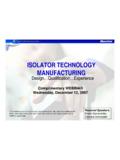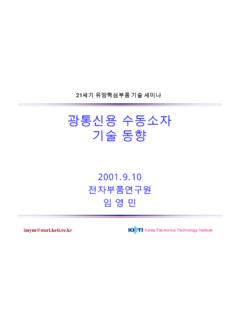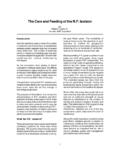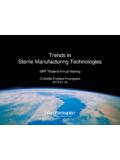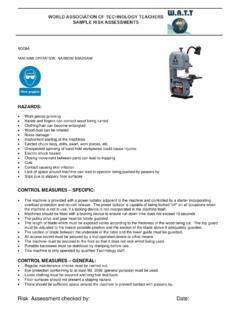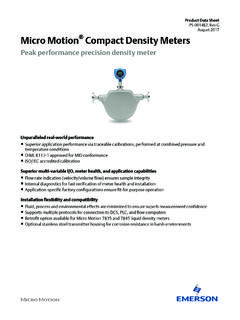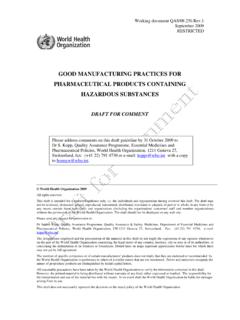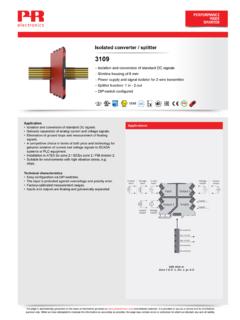Transcription of LabSystem Clean room technology - Room pressure …
1 1 Clean room technology - room pressure controllersChapter LabSystem Planning Manual Air technology for laboratories room technology - room pressure controllersTable of contentsSectionTitle is Clean room technology ? .. Manufacturing Practice .. requirements for the rooms.. room hierarchies .. room pressure .. room leakage .. difference in relation to the surroundings .. pressure ratio with different supply air and exhaust air volume flows changes and air flow routing .. flow .. mixed air flow .. setup of a Clean room .. the volume flow .. room classes .. of safety laboratories in accordance with GenTSV .. room pressure and volume flow controllers .. room pressure controller .. speed of the CRP controller .. accuracy of the CRP controller .. pressure control with CRP.
2 1 .. 2 .. of airtight rooms .. pressure ratios of a volume flow controlled airtight room .. of the pressure difference p .. 112 Clean room technology - room pressure controllersChapter Planning Manual Air technology for laboratoriesTable of contentsSectionTitle of the control tolerance of a volume flow controller .. calculation with a room leakage of m (10 cm ) with equal supply air and exhaust air volume flow .. calculation with a room leakage of m (100 cm ) with equal supply air and exhaust air volume flow .. calculation for a defined positive room pressure of 10 pa with a room leakage of m (100 cm ) .. : room pressure control with volume flow controllers .. pressure control of an airtight room .. of the control tolerance of a room pressure controller .. calculation with a room leakage of m (10 cm ) with constantsupply air volume flow and room pressure controllers.
3 Calculation with a room leakage of m (100 cm ) with constantsupply air volume flow and room pressure controllers .. room pressure controller with double control accuracy .. of the control speed of the CRP room pressure controller of airtight rooms with the VCP volume flow prioritised room pressure controller .. calculation with a room leakage of m (10 cm ) with constantsupply air volume flow and VCP volume flow prioritised room pressure controller volume flow prioritised room pressure controller .. speed of the VCP controller .. accuracy of the VCP controller .. plan VCP .. 100 room pressure monitor .. flow controller VAV .. speed of the VAV controller .. accuracy of the VAV controller .. features CRP room pressure controller .. features VCP volume flow prioritised room pressure controller .
4 Features PM100 room pressure monitor .. features VAV volume flow controller .. overview room pressure controllers, Volume flow controllers, room pressure monitors .. 263 Clean room technology - room pressure controllersChapter LabSystem Planning Manual Air technology for What is Clean room technology ?In many manufacturing sectors, increasingly more deman-ding industrial requirements result in the use of extraordi-narily sophisticated technologies and process techniques, and the methods used are continuously becoming more precise and effective. In order to fulfil market demands - to produce top quality while at the same time using mass production - much stricter general manufacturing require-ments must be adhered to, such as the requirement to keep production plants free of dust and can no longer imagine any modern high-tech industry that does not have the production requirement for Clean room technology as a chain of all measures for the pre-vention or reduction of harmful influences on products or room technology keeps the working area clear of particles from the surrounding air guarantees air filtering and air flow routing offers different levels of negative and positive pressu-re between rooms and room types maintains specific air conditions such as temperature and humidity makes it possible to add high purity media to the process ensures Clean room compatible production technology and processes guarantees surface cleanness of the products.
5 Working surfaces and packaging discharges and disposes of the process exhaust air promotes behaviour on the part of the personnel that is adapted to the process and product and provides the necessary motivation and trainingThe international standards ISO 14644-1 and VDI 2083 define the Classification of Air Cleanliness. The US Fe-deral Standard 209b has been replaced by the standards DIN ISO 14644-1 and DIN ISO 14644-2. Table lists for each ISO class the maximum value for particle concentra-tion (particles per m ).According to the GMP requirements (guidelines for quali-ty assurance of the production processes and production environment during the production of pharmaceutical pro-ducts, active substances and medical products as well as foodstuffs and animal feed), Clean room technology must provide ventilation systems for pharmaceutical, genetic and biotechnology, pharmacies and laboratories.
6 This re-quires a great deal of knowledge and know how. Table lists the correlations between the US, VDI and ISO 209bVDI-2083 DIN ISO 14644 Class Class 1 Class Class 2 Class 1 VDI Class 1 ISO Class 3 Class 10 VDI Class 2 ISO Class 4 Class 100 VDI Class 3 ISO Class 5 Class 1,000 VDI Class 4 ISO Class 6 Class 10,000 VDI Class 5 ISO Class 7 Table Correlation of the US, VDI and ISO classesUS Class 100 corresponds to VDI Class 3 and defines a particle concentration of max. 100 particles with a size of more than m per foot , while DIN ISO Class 5 defi-nes a particle concentration of max. 3520 particles with a size of more than m per m . Good Manufacturing PracticeGMP (Good Manufacturing Practice) provides guidelines for quality assurance of the production processes and pro-duction environment during the production of pharmaceu-tical products, active substances and medical products, and also foodstuffs and animal feed.
7 In pharmaceutical manufacturing, quality assurance plays a central role, because here variations in quality can have a direct impact on the health of values for particle concentration [particles per m ] m1 m5 mISO 1102 ISO 210024104 ISO 31,000237102358 ISO 410,0002,3701,02035283 ISO 5100,00023,70010,2003,52083229 ISO 61,000,000237,000102,00035,2008,320293 ISO 7352,00083,2002,930 ISO 83,520,000832,00029,300 ISO 935,200,0008,320,000293,000 Table ISO Classification of Air Cleanliness4 Clean room technology - room pressure controllersChapter Planning Manual Air technology for laboratoriesA quality management system that meets the GMP re-quirements guarantees product quality and the fulfillment of the obligatory requirements imposed by health authori-ties for the marketing of the Minimum requirements of the roomsClean room classes are based on the supplementary gui-deline to the EU GMP code of practice for the manufactu-re of sterile pharmaceutical products.
8 Critical work steps must be carried out in an area that corresponds to Clean room Class A (highest requirement). The controlled area should preferably meet the criteria of Class B, with appropriate evidence a room corresponding to Class C may be sufficient. When an isolator is used, Clean room Class D is to the controlled area should take place via a room that serves as an air lock; the doors must be bolted shut against each other. Material should be introduced separa-tely from personnel ( via a materials air lock). Clean room hierarchiesAccess to the cleanest room usually takes place via a se-ries of different Clean room areas with decreasing Clean room class. Normally clothes are changed between these areas. To keep contamination of objects that come into contact with the floor ( shoe soles) to a minimum, spe-cial adhesive foot mats are placed in the individual access points.
9 In addition, access to the cleanest room itself takes place via personnel and material air locks, in which strong air flows and filter systems disperse and extract existing particles so that no additional contaminants from outside are brought The room pressureDoors, windows and wall openings are sealed in order to prevent an exchange of air between the laboratory and its surroundings for environmental, hygiene or safety re-asons. However, this not only prevents air exchange but also pressure compensation with the surroundings, which can result in inadmissible pressure differences. Conditions in relation to the surroundings only remain con-stant when the supply air and exhaust air volume flows are equally high. Assuming a typical, maximum variance of the volume flow controllers of +/-5% percent during con-trol operation, the usual room air tightness values are not a problem with today's building standards.
10 However, as soon as increasing emphasis is placed on the air tightness of the building, undesired pressure differences resulting room pressure is dependent on the following parameters: Size of the room leakage area Area of the overflow opening Set ratio of the supply and exhaust air volume flow Control accuracy of the volume flow controller and volume flow difference (supply air - exhaust air) Running time and possible hysteresis of the actuators used The room leakageThe room leakage is usually caused mainly by door ope-nings and pipes fed into walls, untight windows and conce-aled wires in the room interior ( electrical installations in pipes).Increasingly airtight construction methods mean that the-se "natural" balancing openings are no longer present. In-creasingly airtight rooms are very difficult to control with regard to room pressure maintenance (see section ff.)
